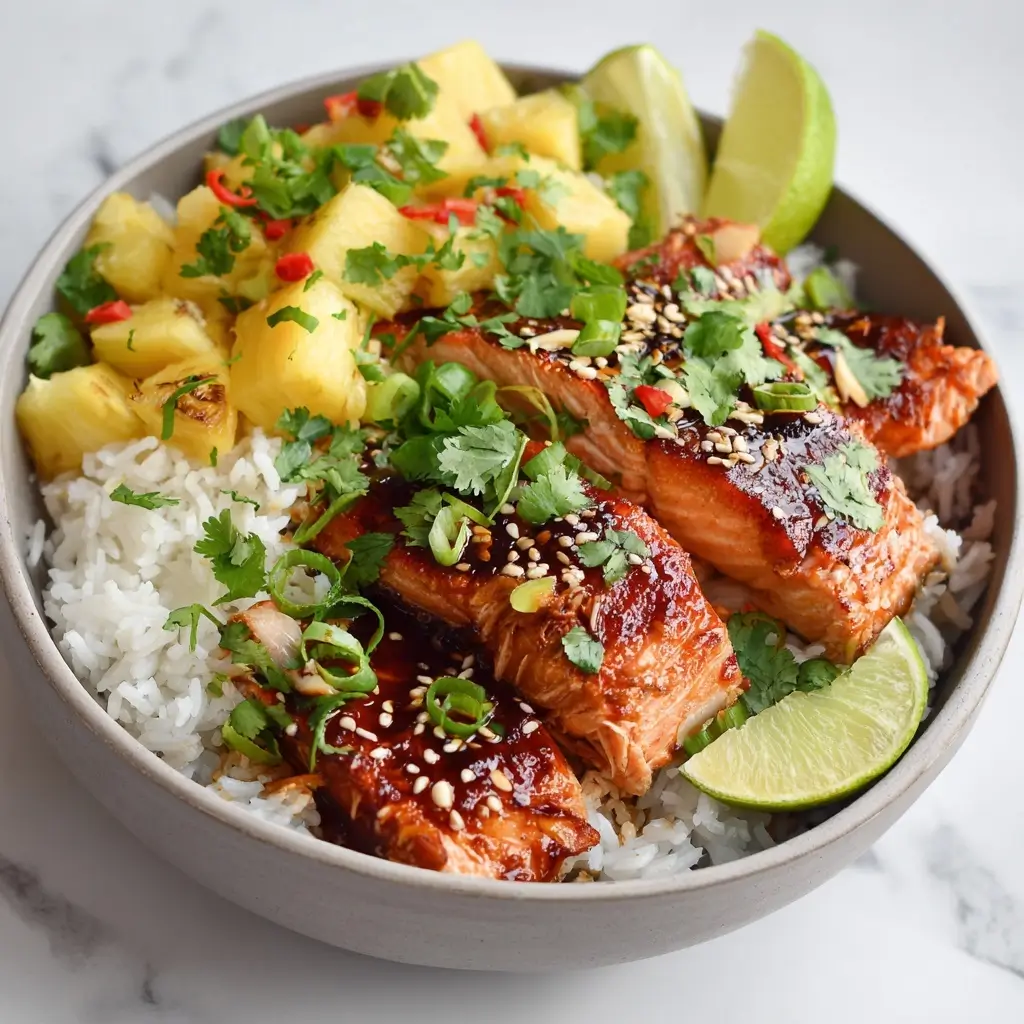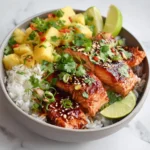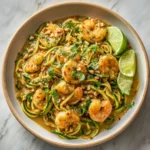Introduction
Teriyaki Salmon Bowls with Pineapple & Rice are a vibrant, satisfying meal that brings together the rich umami of teriyaki-glazed salmon, the natural sweetness of fresh pineapple, and the comforting texture of fluffy rice. This dish is not only visually stunning with its colorful components but also nutritionally balanced, making it ideal for a quick weeknight dinner, a healthy lunch option, or even a meal prep favorite. With layers of flavor and texture, this bowl combines Japanese-inspired teriyaki seasoning with tropical fruit elements to create a culinary experience that’s both familiar and excitingly unique.
Beyond its delicious taste, this dish celebrates the fusion of Eastern and Western culinary traditions. The savory-sweet profile of teriyaki sauce pairs perfectly with the juicy acidity of ripe pineapple, while the omega-3-rich salmon adds heart-healthy benefits. Whether you’re cooking for one or preparing meals for the whole family, Teriyaki Salmon Bowls offer versatility, ease of preparation, and gourmet appeal without requiring advanced kitchen skills. Let’s dive into the history, ingredients, and step-by-step process to make this delectable dish at home.
The History
The roots of teriyaki trace back to Japan, where the term “teri” means luster (referring to the glossy sheen) and “yaki” means grilled or broiled. Originally developed in the 17th century, teriyaki was a method of cooking fish or meat by grilling or broiling it with a glaze made from soy sauce, mirin (sweet rice wine), and sugar. Over time, this technique became popular across Japan and eventually spread worldwide, particularly gaining prominence in Hawaii and other parts of the United States through Japanese immigration.
Hawaiian cuisine played a pivotal role in shaping what we now recognize as modern teriyaki dishes. Local adaptations incorporated island-grown ingredients such as pineapple, coconut, and tropical fruits, which complemented the sweet and savory notes of traditional teriyaki sauce. As a result, Teriyaki Salmon Bowls with Pineapple emerged as a symbol of Pacific Rim fusion—a harmonious blend of Japanese precision and Polynesian abundance. Today, this dish reflects global food trends emphasizing bold flavors, healthy proteins, and colorful plant-based sides, all served in convenient bowl formats that cater to modern lifestyles.
Ingredients Breakdown
To achieve the perfect balance of sweet, salty, tangy, and umami in your Teriyaki Salmon Bowls with Pineapple & Rice, each ingredient plays a vital role. Here’s an in-depth look at what goes into the dish:
- Salmon Fillets: Fresh or thawed skin-on salmon fillets are ideal for this recipe. The high fat content keeps the fish moist during cooking and absorbs the teriyaki glaze beautifully. Look for wild-caught Alaskan salmon when possible for superior flavor and sustainability.
- Soy Sauce: Provides the foundational saltiness and umami depth. Use low-sodium soy sauce if you prefer better control over salt levels. For gluten-free versions, tamari is an excellent substitute.
- Coconut Aminos: A soy-free alternative that mimics the taste of soy sauce but is derived from coconut sap. It offers a slightly sweeter, milder flavor and is popular in paleo and allergen-conscious diets.
- Mirin: A sweet Japanese rice wine that gives teriyaki its signature shine and subtle sweetness. If unavailable, dry sherry or a mix of rice vinegar with a bit of sugar can be substituted.
- Rice Vinegar: Adds brightness and helps balance the richness of the salmon and sauce.
- Maple Syrup or Honey: Natural sweeteners that enhance caramelization and contribute to the glossy finish of the glaze. Pure maple syrup adds a warm depth, while honey lends floral notes.
- Fresh Ginger: Grated ginger infuses the sauce with aromatic warmth and zesty spice, enhancing digestion and overall flavor complexity.
- Garlic: Minced garlic deepens the savory profile and adds pungent undertones that meld well with the sweetness of the sauce.
- Cornstarch: Used as a thickening agent to transform the liquid marinade into a sticky, restaurant-style glaze.
- Water: Dilutes the sauce slightly and ensures even consistency when heating.
- Fresh Pineapple: Chunks of ripe pineapple add juicy sweetness and tropical flair. They contrast beautifully with the savory salmon and provide natural enzymes like bromelain, known for aiding digestion.
- Jasmine or Sushi Rice: Fragrant jasmine rice or short-grain sushi rice forms the base of the bowl. These varieties have a slightly sticky texture that holds up well under saucy toppings.
- Vegetables (optional): Common additions include steamed broccoli, sliced avocado, shredded carrots, edamame, cucumber ribbons, or sautéed bell peppers for added color, crunch, and nutrients.
- Garnishes: Sesame seeds (white or black), sliced green onions, nori strips, cilantro, or chili flakes elevate the presentation and add bursts of flavor and texture.
Step-by-Step Recipe
- Prepare the Rice: Rinse 1 cup of jasmine or sushi rice under cold water until the water runs clear. Combine with 1¾ cups water in a saucepan or rice cooker. Bring to a boil, then reduce heat to low, cover, and simmer for 15–18 minutes (or according to package instructions). Once cooked, let it sit covered for 10 minutes, then fluff with a fork. Stir in a splash of rice vinegar and a pinch of sugar for authentic sushi rice flavor, if desired.
- Make the Teriyaki Sauce: In a small bowl, whisk together ¼ cup soy sauce (or tamari/coconut aminos), 2 tablespoons mirin, 1 tablespoon rice vinegar, 2 tablespoons maple syrup (or honey), 1 teaspoon grated fresh ginger, 1 minced garlic clove, 1 tablespoon water, and 1 teaspoon cornstarch. Set aside.
- Marinate the Salmon: Place 4 salmon fillets (about 6 oz each) in a shallow dish. Pour half of the teriyaki sauce over the salmon, turning to coat evenly. Cover and refrigerate for at least 15 minutes (up to 1 hour) to allow flavors to penetrate.
- Cook the Salmon: Remove salmon from marinade (reserve used marinade). Heat 1 tablespoon of neutral oil (like avocado or grapeseed) in a nonstick skillet over medium-high heat. Place salmon fillets skin-side down and cook for 5–6 minutes until skin is crispy. Flip and cook for another 3–4 minutes, depending on thickness, until internal temperature reaches 145°F (63°C). Transfer to a plate.
- Reduce the Sauce: In the same pan, pour in the reserved marinade plus the remaining unmarinated sauce. Bring to a simmer, stirring frequently. Cook for 3–5 minutes until the sauce thickens into a glossy glaze. Taste and adjust sweetness or saltiness if needed.
- Glaze the Salmon: Return the salmon fillets to the pan, spooning the hot teriyaki sauce over them. Let them warm through for 1 minute, ensuring they’re fully coated.
- Prepare the Pineapple: While the salmon cooks, cut 1 cup of fresh pineapple into bite-sized chunks. You can serve raw for crispness or lightly sauté in a dry pan for 2–3 minutes to caramelize the edges and intensify sweetness.
- Assemble the Bowls: Divide the cooked rice among four bowls. Top each with a glazed salmon fillet, pineapple chunks, and your choice of vegetables (steamed broccoli, avocado slices, edamame, etc.). Drizzle extra teriyaki sauce over the top.
- Garnish and Serve: Sprinkle with toasted sesame seeds, chopped green onions, and optional chili flakes or nori. Serve immediately while warm.
Tips
- Don’t Overcook the Salmon: Salmon continues to cook slightly after being removed from heat. Aim for slightly translucent centers when pulling it off the stove; residual heat will finish the process.
- Crispy Skin Tip: Pat the salmon skin dry before cooking and avoid moving it once placed in the pan. This ensures maximum crispiness.
- Sauce Consistency: If the teriyaki sauce becomes too thick, add a splash of water. If too thin, mix a little more cornstarch with cold water and stir it in while simmering.
- Double the Sauce: Make extra teriyaki sauce and store it in a jar in the fridge for up to two weeks. It’s great for stir-fries, marinades, or dipping sauces.
- Meal Prep Friendly: Cook rice and sauce ahead of time. Store components separately in airtight containers in the refrigerator for up to 3 days. Reheat rice with a sprinkle of water to restore moisture.
- Grill Option: For a smoky twist, grill the marinated salmon instead of pan-searing. Use a fish basket or cedar plank to prevent sticking.
- Use Fresh Ingredients: Fresh ginger and garlic yield far superior flavor compared to powdered versions. Always grate ginger just before using.
- Budget-Friendly Swap: If fresh salmon is expensive, consider using frozen wild-caught fillets—thaw them slowly in the fridge overnight.
- Avoid Burning: Keep the heat at medium-high when reducing the sauce and stir constantly to prevent scorching, especially since sugar burns easily.
- Balance Flavors: After cooking the sauce, taste and adjust: add a squeeze of lime for acidity, a dash more syrup for sweetness, or extra soy sauce for saltiness.
Variations and Customizations
This Teriyaki Salmon Bowl is highly adaptable to different dietary needs, flavor preferences, and seasonal ingredients. Explore these creative variations:
- Protein Swaps: Replace salmon with grilled chicken breast, shrimp, tofu, tempeh, or even scallops. Adjust cooking times accordingly.
- Pineapple Alternatives: Try mango, peaches, kiwi, or grilled apples for similar sweetness with different fruity profiles.
- Grain-Free Version: Substitute rice with cauliflower rice, quinoa, or mixed greens for a lower-carb or keto-friendly option.
- Spicy Kick: Add sriracha, gochujang, or red pepper flakes to the teriyaki sauce for heat lovers.
- Island Style: Incorporate coconut milk into the sauce for a creamy, tropical twist reminiscent of Hawaiian plates.
- Vegetarian/Vegan Adaptation: Use marinated portobello mushrooms or pressed tofu as the main protein and replace honey with agave or brown rice syrup.
- Umami Boost: Add a splash of fish sauce or a teaspoon of miso paste to deepen the savory flavor of the teriyaki glaze.
- Asian Fusion Twist: Top bowls with pickled vegetables, kimchi, or furikake for additional layers of tang and crunch.
- Noodle Base: Instead of rice, use soba noodles, udon, or rice noodles for a heartier, slurpable version.
- Breakfast Bowl: Serve with a soft-poached egg on top for a brunch-inspired take with runny yolk mixing into the sauce.
Health Considerations and Nutritional Value
Teriyaki Salmon Bowls with Pineapple & Rice offer a well-rounded nutritional profile, combining high-quality protein, complex carbohydrates, healthy fats, and essential vitamins and minerals. Here’s a breakdown of key health benefits and considerations:
- Omega-3 Fatty Acids: Salmon is rich in EPA and DHA, which support brain health, reduce inflammation, and promote cardiovascular wellness.
- Lean Protein: Each serving provides approximately 35–40 grams of protein, helping maintain muscle mass and support satiety.
- Fiber-Rich Components: When paired with vegetables and whole grains like brown rice or quinoa, fiber intake increases, supporting digestive health and stable blood sugar levels.
- Vitamin C & Bromelain: Fresh pineapple contains vitamin C and bromelain, an enzyme linked to reduced swelling and improved digestion.
- Antioxidants: Ginger and garlic contain potent antioxidants and anti-inflammatory compounds that may boost immune function.
- Healthy Fats: Salmon delivers monounsaturated and polyunsaturated fats, contributing to hormone production and cellular integrity.
- Sodium Awareness: Traditional soy sauce is high in sodium. Using low-sodium soy sauce or coconut aminos helps manage blood pressure and fluid retention.
- Sugar Content: The natural sugars in pineapple and added sweeteners (maple syrup/honey) should be considered for those monitoring glucose levels. Reducing sweetener quantity or using monk fruit syrup can help.
- Calorie Range: A typical bowl ranges between 500–700 calories depending on portion sizes, oil usage, and rice type. Opt for smaller portions or vegetable-heavy builds for weight management.
- Allergies & Sensitivities: Ensure gluten-free options (tamari instead of soy sauce), soy-free (coconut aminos), and fish-safe environments if allergies are a concern.
Ingredients
- 1 cup jasmine rice or sushi rice
- 1¾ cups water (for rice)
- 4 (6 oz) salmon fillets, skin-on
- ¼ cup low-sodium soy sauce (or tamari/coconut aminos)
- 2 tablespoons mirin (Japanese sweet rice wine)
- 1 tablespoon rice vinegar
- 2 tablespoons pure maple syrup or honey
- 1 teaspoon freshly grated ginger
- 1 clove garlic, minced
- 1 teaspoon cornstarch
- 1 tablespoon water (for sauce)
- 1 tablespoon neutral oil (avocado, grapeseed, or vegetable)
- 1 cup fresh pineapple, cubed
- 1 cup steamed broccoli florets
- ½ avocado, sliced
- 2 green onions, thinly sliced
- 1 tablespoon toasted sesame seeds
- Optional: chili flakes, nori strips, edamame, cucumber
Directions
- In a saucepan or rice cooker, rinse the rice thoroughly. Add water and cook according to instructions. Once done, let stand covered for 10 minutes, then fluff and set aside.
- Whisk together soy sauce, mirin, rice vinegar, maple syrup, grated ginger, minced garlic, cornstarch, and 1 tablespoon water in a small bowl to make the teriyaki sauce.
- Pour half of the sauce over the salmon fillets in a dish. Marinate in the refrigerator for 15–60 minutes.
- Heat oil in a large nonstick skillet over medium-high heat. Remove salmon from marinade (reserve liquid) and place skin-side down in the pan.
- Cook for 5–6 minutes until skin is golden and crispy. Flip and cook for another 3–4 minutes until salmon is cooked through. Transfer to a plate.
- Pour reserved marinade and remaining sauce into the same skillet. Simmer over medium heat for 3–5 minutes, stirring often, until thickened and glossy.
- Return salmon to the pan, spooning sauce over each fillet. Warm for 1 minute, then remove.
- While salmon cooks, prepare pineapple—either serve raw or lightly sauté for enhanced flavor.
- To assemble bowls: divide rice among four serving dishes. Top with salmon, pineapple, broccoli, avocado, and any additional veggies.
- Drizzle with extra teriyaki sauce and garnish with green onions, sesame seeds, and optional spices.
- Serve immediately and enjoy!
FAQ
Can I use frozen salmon?
Yes, frozen salmon works well. Thaw it slowly in the refrigerator overnight for best texture. Avoid microwaving, as it can partially cook the fish.
Is teriyaki sauce gluten-free?
Traditional soy sauce contains wheat, so it’s not gluten-free. Use tamari or certified gluten-free soy sauce for a safe alternative.
Can I bake the salmon instead of pan-searing?
Absolutely! Preheat oven to 400°F (200°C). Place marinated salmon on a lined baking sheet and bake for 12–15 minutes. Brush with reduced sauce halfway through.
How do I store leftovers?
Store components separately in airtight containers in the fridge for up to 3 days. Reheat rice with a few drops of water to prevent drying out.
Can I make this ahead for meal prep?
Yes! Cook rice, sauce, and salmon in advance. Keep chilled and assemble bowls fresh before eating to maintain texture.
Why did my sauce turn out too salty?
You may have used regular soy sauce instead of low-sodium. Balance future batches with a touch more sweetener or a splash of water.
Can I use canned pineapple?
Fresh is preferred for texture and less sugar, but canned pineapple in juice (not syrup) can work in a pinch. Drain and pat dry before use.
What side dishes go well with this bowl?
Consider miso soup, seaweed salad, pickled ginger, Asian slaw, or spring rolls for a complete Japanese-inspired meal.
Is this dish suitable for kids?
Yes! Most children enjoy the sweet-savory flavor. Cut salmon into smaller pieces and omit spicy garnishes.
Can I freeze teriyaki salmon?
It’s best enjoyed fresh, but you can freeze cooked salmon for up to 2 months. Thaw in the fridge and reheat gently to preserve moisture.
Summary
Teriyaki Salmon Bowls with Pineapple & Rice are a nutritious, flavorful fusion dish that blends Japanese tradition with tropical freshness, offering a balanced meal packed with omega-3s, fiber, and vibrant colors. Easy to customize and perfect for meal prep, this bowl satisfies taste buds and nourishes the body with every bite.










